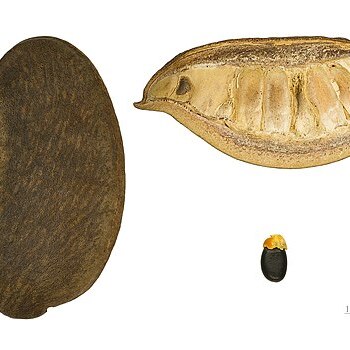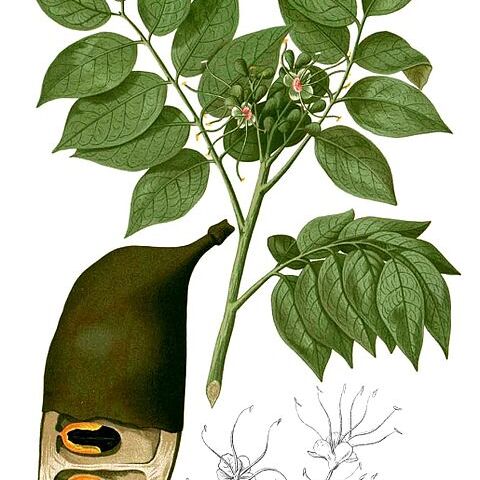Trees. Stipules interpetiolarly connate at base. Leaves paripinnate. Leaflets chartaceous, shortly petiolulate, petiolule often turned or twisted. Inflorescences terminal or axillary, racemose, often fasciculate or paniculate; bracts and bracteoles small, often caducous. Flowers bisexual, zygomorphic, pedicelled. Hypanthium cupular, narrowly infundibuliform or cylindric, puberulous outside, glabrous inside. Calyx lobes 4, imbricate, puberulous on both surfaces. Petals only one fully developed, large, flabellate, lower half narrowed into a claw, the others small or absent. Disk absent. Stamens 9, usually (5-)7 fertile, almost equal, the others reduced; anthers dorsifixed. Ovary stipi-tate (stipe adnate to the hypanthium), 3-8(or more)-ovuled; style slender, almost as long as the stamens; stigma small, round. Pods oblong, obliquely oblong, or slightly rhomboid, compressed, black when ripe, glabrous, 2-valved, valves thick, woody, often 3 (or more)-seeded. Seeds ellipsoid, ovoid-oblong or broadly ellipsoid, smooth, exalbuminous; aril yellow, orange, or red, often 2-lobed, covering the seed for up to half or more of its length.
Trees. Leaves abruptly pinnate; stipules caducous, minute; leaflets in few pairs. Panicles terminal; bracts and bracteoles deciduous or ± persistent, ovate, slightly thick, not colored. Flowers bisexual, pedicellate. Calyx tubular, with a disk in throat; lobes 4, slightly unequal in size, leathery, imbricate. Petal 1, suborbicular or reniform, clawed, others rudimentary or absent. Stamens 7 or 8; filaments elongated, base partly united or free; anthers ovoid or oblong, opening lengthwise; staminodes 2, very small. Ovary stalked, stalk adnate to calyx tube; ovules few to numerous; style filiform; stigma subcapitate, small. Legume slightly compressed, oblong or obliquely oblong, woody, thick, 2-valved, transversely septate between seeds. Seeds ovoid or oblong, with horny, hard, arilloid funicle at base, without endosperm; cotyledons fleshy, ± flat; embryo straight.
Leaves paripinnate; leaflets opposite or subopposite, without gland dots, but sometimes with a dot-like gland near the base of the leaflet; petiolules twisted; stipules intrapetiolar, upper parts early caducous.
Seeds up to 10, without areole, lying in compartments in a white pithy endocarp, with a yellow or red fleshy aril partially enveloping the seed.
Flowers in racemes or panicles, spirally arranged on the inflorescence axis; bracts small, caducous; bracteoles 2, small, caducous.
Fertile stamens 7–9, filaments long; anthers dorsifixed, dehiscing by longitudinal slits; 2 staminodes often present.
Ovary stipitate; ovules usually 10–15; style elongate, filiform; stigma terminal, small.
Pods oblong or reniform, compressed, with thick woody valves, tardily dehiscent.
Corolla of a single large petal, with up to 4 represented as minute rudiments.
Sepals 4, subequal, differentiated into 2 outer and 2 inner, imbricate.
Trees, evergreen or deciduous, unarmed.
Hypanthium present, generally elongate.


